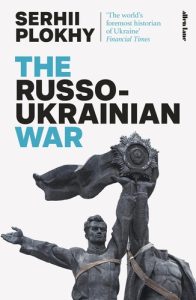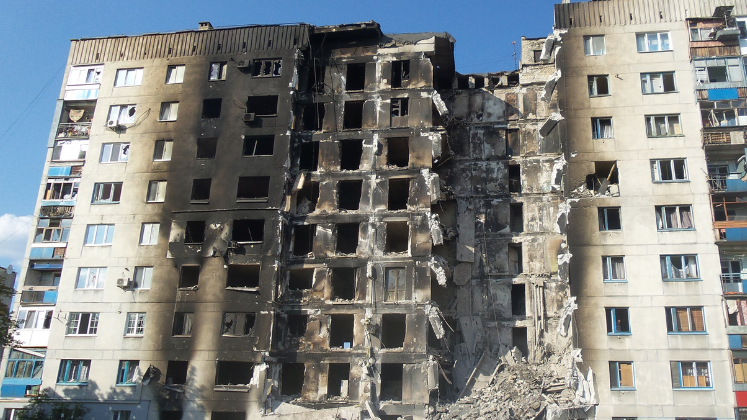In The Russo-Ukrainian War, Serhii Plokhy interrogates the war in Ukraine, setting it within the historical and geopolitical context of the region since Russia’s 2014 annexation of Crimea, the Cold War and the longer history of national identity and sovereignty in both countries. Plokhy’s sharp, eminently readable analysis should be read by anyone seeking to make sense of the crisis, writes Gary Wilson.
The Russo-Ukrainian War. Serhii Plokhy. Penguin. 2023.
 Few events since early 2022 have generated as much attention from observers of global affairs as Russia’s attack on Ukraine and the ensuing conflict. Serhii Plokhy’s new book is an ambitious attempt to chart this ongoing conflict and arguably represents the first detailed account of the war so far from a historical contextual perspective. A Harvard History Professor, Plokhy is the acclaimed author of a work on the Chernobyl nuclear disaster and is widely regarded as Ukraine’s preeminent living historian.
Few events since early 2022 have generated as much attention from observers of global affairs as Russia’s attack on Ukraine and the ensuing conflict. Serhii Plokhy’s new book is an ambitious attempt to chart this ongoing conflict and arguably represents the first detailed account of the war so far from a historical contextual perspective. A Harvard History Professor, Plokhy is the acclaimed author of a work on the Chernobyl nuclear disaster and is widely regarded as Ukraine’s preeminent living historian.
Although much of the book comprises an effective military history of the events since Russia attacked Ukraine in February 2022, the war is conceptualised in much broader terms, with the earlier chapters tracing the complex history and tensions between the two states as far back as the fifteenth century. This historical context is supported by the inclusion of a series of maps which illustrate how the borders of Russian and subsequently Soviet territory changed over time, as well as NATO and EU membership across the continent of Europe. Referencing post-2022 developments, additional maps illustrate the territorial control of Ukraine’s various regions, while a world map demonstrates relative support globally for Russia and Ukraine respectively.
The latest conflict can only be understood by reference to the longer-term history of Russian-Ukrainian relations
The latest conflict can only be understood by reference to the longer-term history of Russian-Ukrainian relations. The first seven chapters of the book are dedicated to this purpose, charting developments over several centuries, with a focus on events since the end of the Cold War. Brought into the Russian empire during the rule of the Tsars, the myth of “Kyivan Rus” is central to understanding the cultural and symbolic significance of the territory of Ukraine to Russia. This effectively considers that the Russian state originated in Kyiv. Much of Ukraine’s history can be conceived of as an ongoing struggle between its attempt to assert its national identity and the efforts of external actors to overwhelm it. Though incorporated within the Russian dominated Soviet Union, Ukraine enjoyed a status distinct from that of the other Soviet republics, achieving prominence during Khrushchev’s time in power. The collapse of the USSR in 1991 gave birth to both new pressures for Ukraine to forge a post-Soviet identity of its own and a Russian desire to retain oversight of its political direction of travel.
The collapse of the USSR in 1991 gave birth to both new pressures for Ukraine to forge a post-Soviet identity of its own and a Russian desire to retain oversight of its political direction of travel
Plokhy’s account of developments in the first two decades of the post-Cold War era offer pertinent insights. The period was characterised by conflicting positions, each of which dominated at different points: the desire of Ukraine’s leadership to move politically closer to the EU and NATO, and a wish to preserve close ties with Russia, the two being incompatible in the eyes of Russia especially. The status of Crimea dominated much of the diplomatic agenda at this time, being both strategically important to Russia due to the presence there of the Black Sea fleet, and the only Ukrainian region with a Russian majority population. International treaties and agreements such as the Budapest Memorandum, underpinned by the involvement of other key third-party actors, were central to ensuring the territorial integrity and sovereignty of Ukraine against Russian interference.
Relations between Russia and Ukraine deteriorated in the aftermath of 2014’s ‘Revolution of Dignity’ which saw the removal from office of the Russian backed President Yanukovych after he reneged on signing a cooperation agreement with the EU in the face of pressure from his Russian counterpart, Vladimir Putin. Troubled by the eastward expansion of both NATO and the EU, Putin saw Ukraine as an effective buffer state for Russian defence purposes. The toppling of Yanukovych was swiftly followed by Russia’s annexation of Crimea. Mirroring claims made after the 2022 invasion, Putin painted the Russian interference as benign and welcomed by a local population under threat from Ukrainian nationalists. While condemned by the international community, Crimea’s annexation was followed by that of much of the Donbas region. At the same time, Ukraine’s independent political identity continued to grow, and its leadership continued efforts towards EU and NATO membership. In retaliation, Russia began preparations for war, building up its forces along the border from 2021. Putin suggested the “special military operation, “was of a humanitarian character designed to “denazify” Ukraine.
Putin painted the Russian interference as benign and welcomed by a local population under threat from Ukrainian nationalists
The subsequent four chapters provide a more traditional military history, charting the course of the war itself over its first year or so. Some key themes and trends are evident during this time. Confounding expectations that it would be quickly overpowered, Ukraine has displayed a remarkable defiance against the Russian aggressor. President Zelensky rapidly emerged as the face of Ukrainian resistance, while mayors played a vital role in rallying local populations, launching brave demonstrations against Russian occupying forces. Simultaneously, it became apparent that Russia had limited resources for the military escapade which it had embarked upon, while morale among its soldiers seemed poor. Russian forces were accused of committing atrocities such as sexual violence and civilian massacres that violated core tenets of international humanitarian law, while UNESCO in mid-July 2022 identified the destruction or damage of 163 culturally important sites, a number which continued to grow. The toll of the conflict on the civilian population has been well documented, triggering a refugee crisis in Europe. Plokhy dwells on the battles for strategically significant targets, such as Kharkiv and Kherson, and explains Putin’s annexation of four Ukrainian oblasts (post-Soviet provinces) as part of his agenda intended to present himself as a modern-day Peter the Great.
President Zelensky rapidly emerged as the face of Ukrainian resistance, while mayors played a vital role in rallying local populations, launching brave demonstrations against Russian occupying forces
The Russo-Ukrainian war and its potential outcomes cannot be understood without reference to the roles of other influential states. The final two chapters analyse the positions taken by key international players. The significant international opposition to Russia has been evidenced by the heavy sanctions imposed by the US and EU. The US has been vehement in its diplomatic and practical support of Ukraine, including through the provision of arms. Initial hesitation by some European states which had been in the process of developing close economic ties with Russia – in particular Germany, through the Nordstream II gas pipeline project – allowed Britain to take early charge in attempting to shape a new post-Brexit European alliance. Putin’s attempts to strengthen alliances with states further afield were of limited effect, although it has retained some implicit support from the likes of India and China.
Initial hesitation by some European states which had been in the process of developing close economic ties with Russia – in particular Germany, through the Nordstream II gas pipeline project – allowed Britain to take early charge in attempting to shape a new post-Brexit European alliance
The Russo-Ukrainian War deserves to be read by anyone seeking to make sense of the crisis. It is comprehensive yet concise, eminently readable, and carefully sourced. Its only limitation lies in the fact that it attempts to tell an unfinished story. That said, if one regards the current war as part of a much longer-term struggle, then there will not be an end in the foreseeable future. Plokhy concludes by framing the conflict as the latest war of “national liberation” and as one in a long tradition of those which accompanied the decline and disintegration of world empires. Ukraine is likely to emerge from it more united, supported by international solidarity rallied behind its cause. While Russia and China seek a return to a world built upon spheres of influence, the US and EU are firmly resisting this, leaving Russia with few allies. The inference is one of optimism for the future of Ukraine.
Note: This review gives the views of the author, and not the position of the LSE Review of Books blog, or of the London School of Economics and Political Science. The LSE RB blog may receive a small commission if you choose to make a purchase through the above Amazon affiliate link. This is entirely independent of the coverage of the book on LSE Review of Books.
Main Image: kibri_ho on Shutterstock.







